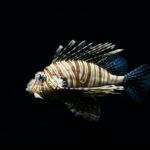Biomechanics of Fish Inner Ear: Sound Detection in Aquatic Environments
Sound is crucial for communication among fishes and other aquatic animals. Fishes can detect low-level sounds, alerting them to predators or aiding in mate location. While similar to terrestrial mammals’ auditory systems, fishes lack an outer ear, middle ear, or cochlea. This article examines sound propagation in water and its interaction with the fish’s peripheral auditory systems, which is vital for understanding fish hearing and inner ear biomechanics.
Underwater Sound Propagation
Sound travels at approximately 340 m/s in air, but underwater, it moves with minimal attenuation at about 1500 m/s, making it effective for long-distance information transfer.
Longitudinal Waves:
Sound propagates as a longitudinal wave, meaning local fluid motion parallels the wave’s direction.
Acoustic Pressure:
As the wave moves, fluid particles are compressed and rarefied, creating pressure fluctuations known as acoustic pressure, measured in hertz (Hz).
Tonal vs. Complex Sounds:
Tonal sounds consist of a single frequency, while complex sounds have multiple frequencies.
Sound Source
Near a sound source, the ‘near field,’ acoustic particle motion is driven by fluid mass moving back and forth. Momentum and velocity peak near the source and decrease as the wave enters the ‘far field,’ where propagation is governed by the fluid’s characteristics and boundaries.
Far Field – The far field is significantly distant from the source compared to its physical dimensions and wavelength.
Fish and Sound Interaction
Sound interaction with fishes depends on the fish’s length relative to the wavelength.
Frequency Range: Most fish species hear and produce sounds below 1000 Hz, with wavelengths over 1.5 m.
Uniform Acoustic Pressure: Fishes experience uniform acoustic pressure across their bodies as a sound wave passes.
Synchronization with Sound Waves: Due to their water-based composition, fishes move in sync with the incoming sound wave.
Hearing Mechanics
Fish detect various sounds, but inner ear structure varies among species, leading to differences in auditory bandwidth and thresholds. The inner ear, located in the cranial cavity, includes semicircular canals for angular acceleration detection and otolith organs (utricle, saccule, lagena) for sound detection.
Otolith Organs:
In fishes, these organs, containing otoconia or otoliths, detect sound through mechanosensory hair cells.
Relative Motion:
The denser otoliths or otoconia lag behind the body during sound wave movement, creating motion relative to the sensory epithelium and bending ciliary bundles, which send signals to the brain.
The otolith organs in all fishes are directly stimulated by acoustic particle motion, known as the ‘direct path.’ In fishes with swim bladders, sound pressure fluctuations can also indirectly stimulate the inner ear through particle motion generated by these gas-filled organs, providing an ‘indirect path’ for additional signals.
Enhanced Hearing Anatomy
Certain species, like cyprinids and otophysans, possess modified vertebrae called Weberian ossicles, connecting the swim bladder to ear fluids. This connection enhances relative motion within the saccule, lowering auditory thresholds and broadening bandwidths.
Gas-Filled Structures:
Other species, like anabantids and mormyrids, have different mechanisms coupling gas-filled structures to the ear, allowing detection of frequencies up to 5000 Hz.
Swim Bladder Adaptations:
Sciaenids and soldier fishes possess swim bladders with anterior horns that enhance hearing sensitivity and bandwidth.
At least two clupeiform species detect ultrasound at frequencies of 100 kHz or higher. In these species, the swim bladder, inner ear, and lateral line system are linked through auditory bullae, enhancing hearing sensitivity. Some species show increased sensitivity at lower frequencies, possibly due to oversized otoliths.
———————————————————————————–
———————————————————————————-
Fishes navigate complex acoustic environments, efficiently detecting and using acoustic signals. The diverse inner ear and peripheral anatomical structures across species contribute to the wide range of auditory thresholds and bandwidths, highlighting the intricate biomechanics of sound detection in fishes.




















